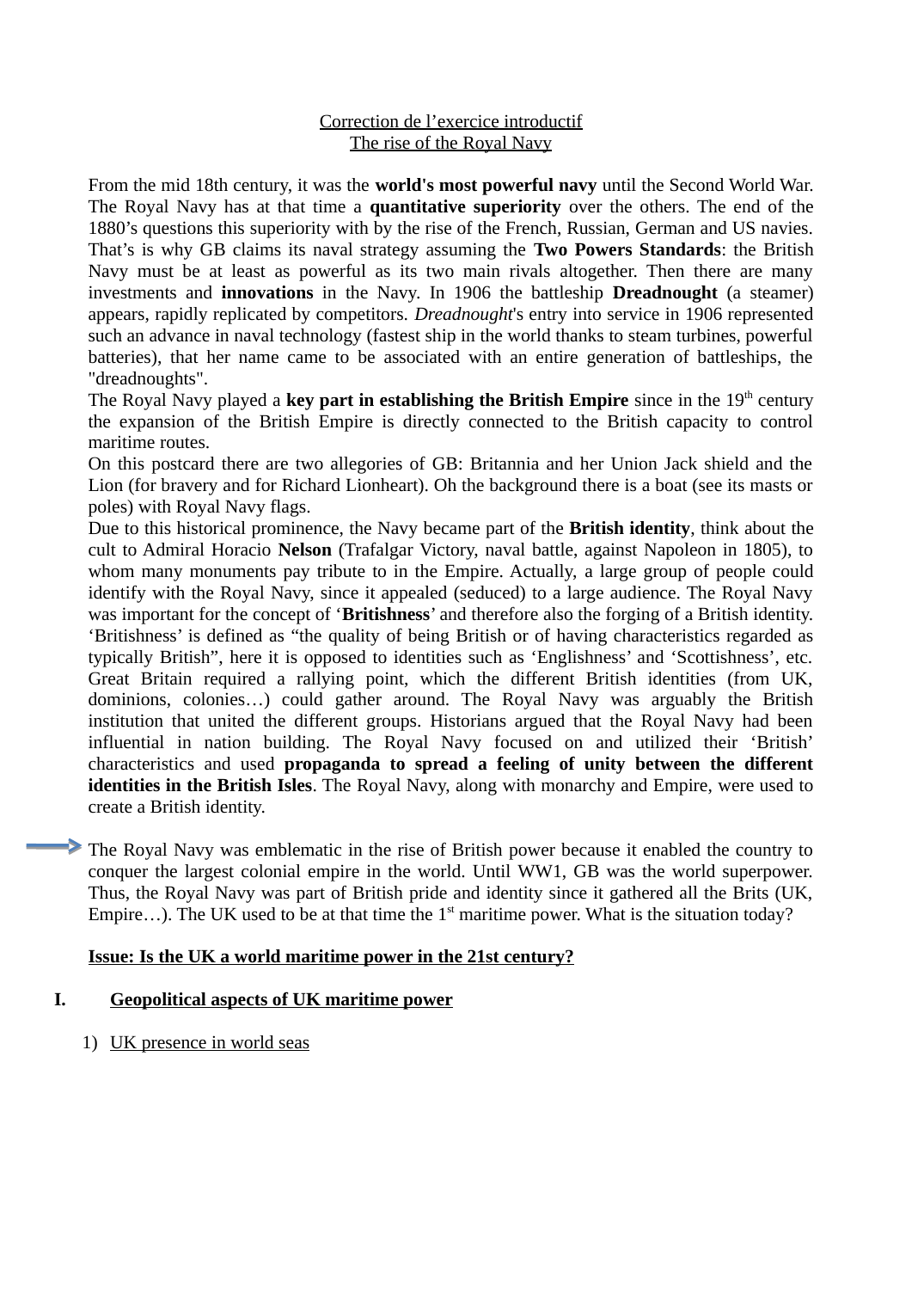Royal Navy
Publié le 28/03/2021
Extrait du document
«
Correction de l’exercice introductif
The rise of the Royal Navy
From the mid 18th century, it was the world's most powerful navy until the Second World War.
The Royal Navy has at that time a quantitative superiority over the others.
The end of the
1880’s questions this superiority with by the rise of the French, Russian, German and US navies.
That’s is why GB claims its naval strategy assuming the Two Powers Standards : the British
Navy must be at least as powerful as its two main rivals altogether.
Then there are many
investments and innovations in the Navy.
In 1906 the battleship Dreadnought (a steamer)
appears, rapidly replicated by competitors.
Dreadnought ' s entry into service in 1906 represented
such an advance in naval technology (fastest ship in the world thanks to steam turbines, powerful
batteries), that her name came to be associated with an entire generation of battleships, the
"dreadnoughts".
The Royal Navy played a key part in establishing the British Empire since i n the 19 th
century
the expansion of the British Empire is directly connected to the British capacity to control
maritime routes.
On this postcard there are two allegories of GB: Britannia and her Union Jack shield and the
Lion (for bravery and for Richard Lionheart).
Oh the background there is a boat (see its masts or
poles) with Royal Navy flags.
Due to this historical prominence, the Navy became part of the British identity , think about the
cult to Admiral Horacio Nelson (Trafalgar Victory, naval battle, against Napoleon in 1805), to
whom many monuments pay tribute to in the Empire.
Actually, a large group of people could
identify with the Royal Navy, since it appealed (seduced) to a large audience.
The Royal Navy
was important for the concept of ‘ Britishness ’ and therefore also the forging of a British identity.
‘Britishness’ is defined as “the quality of being British or of having characteristics regarded as
typically British”, here it is opposed to identities such as ‘Englishness’ and ‘Scottishness’, etc.
Great Britain required a rallying point, which the different British identities (from UK,
dominions, colonies…) could gather around.
The Royal Navy was arguably the British
institution that united the different groups.
Historians argued that the Royal Navy had been
influential in nation building.
The Royal Navy focused on and utilized their ‘British’
characteristics and used propaganda to spread a feeling of unity between the different
identities in the British Isles .
The Royal Navy, along with monarchy and Empire, were used to
create a British identity.
The Royal Navy was emblematic in the rise of British power because it enabled the country to
conquer the largest colonial empire in the world.
Until WW1, GB was the world superpower.
Thus, the Royal Navy was part of British pride and identity since it gathered all the Brits (UK,
Empire…).
The UK used to be at that time the 1 st
maritime power.
What is the situation today?
Issue: Is the UK a world maritime power in the 21st century?
I.
Geopolitical aspects of UK maritime power
1) UK presence in world seas.
»
↓↓↓ APERÇU DU DOCUMENT ↓↓↓
Liens utiles
- Comment le renforcement du pouvoir royal permet-il l’affirmation de l’Etat en France aux XVIe-XVIIème siècles ?
- Joachim Du Bellay, « Esprit royal, qui prends de lumière éternelle »
- Vous supposerez qu'après la mort de Pascal, un janséniste, son ami, consigne dans ses Mémoires les impressions qu'il éprouve et les souvenirs qu'il tient à fixer. Il rappelle d'abord les services que Pascal a rendus à la cause de Port-Royal; il caractérise l'ardeur avec laquelle Pascal a cherché la vérité dans ses « conversions » ; il parle du livre ébauché par Pascal en vue d'ébranler les indifférents et de les ramener à Jésus. Enfin, il cite quelques-unes des Pensées, pour en montre
- PORC ROYAL
- Thierry Maulnier écrit dans son Racine (p. 70, Gallimard, édit.) : « Montrer sur la scène des monstres ou des meurtres, montrer du sang, montrer de brillants costumes ou des foules ou des batailles, tout cela est bon pour des primitifs, des romantiques ou des enfants. La grandeur et la gloire de l'homme sont d'avoir cessé de montrer parce qu'il a appris à dire. L'art le plus affiné et le plus complexe est nécessairement l'art où le langage - honneur des hommes, dit le poète - a la plac


